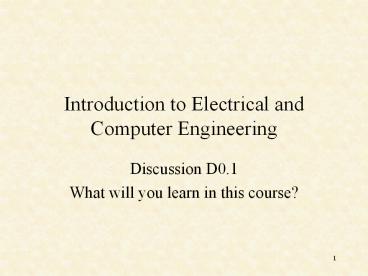Introduction to Electrical and Computer Engineering - PowerPoint PPT Presentation
1 / 11
Title:
Introduction to Electrical and Computer Engineering
Description:
Introduction to Electrical and Computer Engineering Discussion D0.1 What will you learn in this course? Think of some product that uses electricity Toaster Washing ... – PowerPoint PPT presentation
Number of Views:55
Avg rating:3.0/5.0
Title: Introduction to Electrical and Computer Engineering
1
Introduction to Electrical and Computer
Engineering
- Discussion D0.1
- What will you learn in this course?
2
Think of some product that uses electricity
- Toaster
- Washing machine
- Radio, TV, iPod
- Computer
- Automobile
What do all these products have in common?
3
A typical product
Input Sensors Analog circuits
Processing Digital circuits
Output Actuators Magnetic circuits
4
A typical product
Input Sensors Analog circuits
Processing Digital circuits
Output Actuators Magnetic circuits
In the lab you will work in groups of four and
throughout the course your group will invent and
design some useful product that
- uses the amount of squeezing of a hand grip as
input - processes this data digitally, and
- causes something to move using a relay or motor
5
DC circuits Op amps
Part 1 of the course
Topic Lecture Pages
Analog digital signals, voltage and current, circuit elements D1.2 1 -- 29
Ohm's law and Kirchoff's law, examples D2.1 34-54, 78-79
Binary numbers, R2-R ladder network, D/A converter D2.2 App D, F
Nodal analysis D2.3 59-68
Mesh analysis D2.4 69-74
Circuit Theorems, Thevenin's and Norton's theorems D2.5 75-78, 80-86
Wheatstone bridge D2.6 87-89
Ideal Op Amp, Non-inverting amplifier, Inverting amplifier D3.1 328-334
Differential amplifier, summing circuit, current-to-voltage converter D3.1 334-336, 340
6
Current
7
Voltage
8
Power
9
The Electromagnetic Spectrum
10
Digital circuits
Part 2 of the course
Topics Lecture Pages
Digital systems, number systems D4.1 500-503, D
Basic logic gates, DeMorgan's theorem D5.1 E
Sum of Products and Product of Sums design D5.1 E
Implementing logic gates and digital circuits, CPLDs D5.2 G
Boolean algebra, Karnaugh maps D6.1, D6.2 504-516
Implementing combinational circuits using Verilog D7.1 517-524
Semiconductors, diodes, LEDs, 7-segment displays D7.2 354-365, 394
Latches and flip-flops D8.1 524-530, H
Counters D8.2 H
Implementing sequential circuits using Verilog D8.2 H
State machines D8.3 530-534
A/D converters, pulse-width modulation D8.3
11
AC circuits Magnetic circuits Motors
Part 3 of the course
Topics Pages
Capacitors and Inductors 104-113
Sinusoidal functions, complex numbers, phasors 144-152
Impedance and admittance 153-160, 174-181
Instantaneous power, average power, RMS values 200-207
Power factor, residential AC power circuits 207-220
DC machines 240-249
dc motors, dc generators 249-259
Magnetic circuits, mutual inductance 379-388
Linear transformer, ideal transformer 582-591
Power supply circuits 591-602































